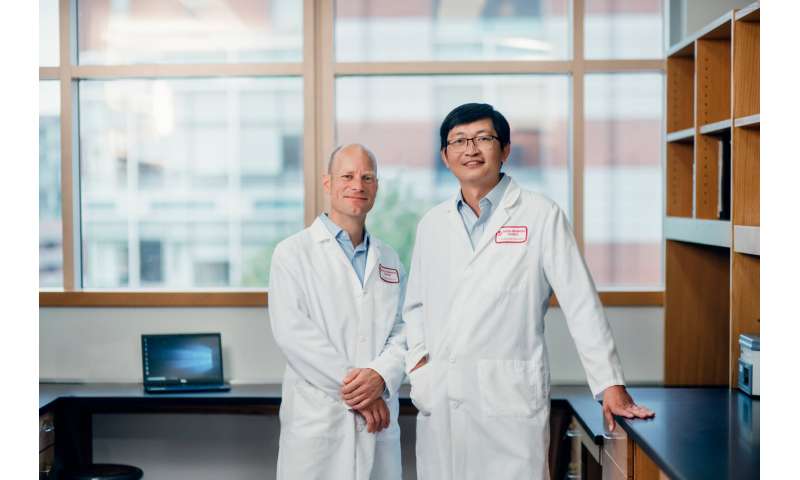
Type 1 diabetes occurs when a person’s own immune system destroys insulin-producing beta cells in the pancreas. In recent years, scientists have learned how to grow large volumes of replacement beta cells, but the researchers are still trying out many options to protect these cells against the immune attack. Joslin Diabetes Center researchers now have found an unusual strategy that eventually may help to guard such transplanted beta cells or to slow the original onset of the disease.
Research in mouse models and in human cells has shown that targeting a protein called renalase may protect beta cells against autoimmune attack by strengthening them against stress, says Stephan Kissler, an investigator in Joslin’s Section on Immunobiology, associate professor of medicine at Harvard Medical School, and co-senior author on a paper describing the work in Nature Metabolism.
Kissler, co-senior author Peng Yi, Ph.D., and their colleagues also demonstrated that an existing FDA-approved drug inhibits renalase and increases the survival of beta cells in those lab models.
The Joslin study joins a growing set of evidence suggesting that functional problems with beta cells themselves may help to trigger the autoimmune attack in type 1 diabetes, say Kissler and Yi, who is an assistant investigator in the Islet Cell and Regenerative Biology Section. “You might have genes that make the beta cell a little bit dysfunctional and more prone to becoming a target of the immune system,” Kissler explains.
The research began with a casual hallway conversation between Kissler and Yi about potential ways to protect beta cells from autoimmune attack. The two ended up launching a bold gamble to try inhibiting genes across the genome, one at a time, using a screening technique based on the CRISPR gene-editing method with a beta cell line from a “non-obese diabetic” (NOD) mouse that models type 1 diabetes. “Whole genome CRISPR screening is a powerful tool for new target discovery and we hoped that it would help us find any mutations that protect the beta cell,” Yi says.
The CRISPR screen for surviving beta cells produced a dozen genes of interest. The most striking was the gene for renalase, which previous research had shown is associated with type 1 diabetes.
Next, the researchers created NOD mouse beta cells, some with the renalase gene functionally “knocked out” and some not. They transplanted these cells to NOD mice with autoimmune diabetes.
Intact beta cells died off—but the renalase knock-out cells survived. “This was a very black-and-white research model,” Kissler comments. “If the cells aren’t protected, they’re gone.”
The investigators then looked to see if the cells that lacked the renalase gene provoked a diminished response from T immune cells (which spearhead the autoimmune assault) in a dish. The scientists found that one type of T cell was less likely to attack these knockout cells than to attack normal beta cells.
But what was slowing this autoimmune assault?
In earlier work to analyze beta cell survival, Yi had analyzed how the cells respond to a condition called endoplasmic reticulum (ER) stress. Now when the team tried three ways of introducing ER stress to mouse beta cells in a dish, the researchers saw that the renalase mutation was protecting against this condition.
In the next step, to see if the same mechanisms were at work in human cells, the team joined up with Douglas Melton of the Harvard department of Stem Cell and Regenerative Biology to create human beta cells for similar tests in a dish. “Again, we saw that the renalase knockout protected cells against ER stress,” Kissler says.
The functions of renalase are not well understood, but Yi and Kissler knew that the protein is an enzyme (which often can be targeted by drug compounds) and that other scientists had produced a three-dimensional crystal structural map of the protein.
Wondering if this map would give clues to uncover a compound that could target renalase, the Joslin investigators began working with Celia Schiffer of the University of Massachusetts Medical School. Structural biologists at the university’s structure-based drug design core facility soon noticed that renalase is very similar to another enzyme that is inhibited by existing drugs—including one drug known as pargyline that was approved by the Food & Drug Administration almost 60 years ago to treat hypertension.
Testing pargyline in their mouse transplant model, the Joslin researchers found that the drug protected beta cells extremely well, says Kissler. Studying it in the mouse beta cells themselves, the scientists demonstrated that pargyline indeed was protecting against ER stress. In experiments with human cells, pargyline also displayed a protective effect.
Source: Read Full Article
